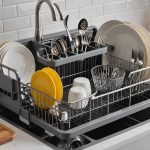Understand Microwave Radiation
Microwave radiation, a type of non-ionizing electromagnetic radiation, lies within the electromagnetic spectrum between radio waves and infrared radiation. Its primary use is in microwave ovens, where it stimulates water molecules in food, generating heat. Microwave radiation’s interaction properties enable it to cook food efficiently, as the energy is absorbed quickly by water, fats, and sugars present within the items.
Electromagnetic Fields (EMFs) are naturally or artificially produced energy fields encompassing a wide range of frequencies, including microwaves. Since microwaves fall under the EMF category, understanding their health implications is integral. Generally, low-level EMF exposure, such as that from a household microwave, poses minimal health risks when safety standards are adhered to.
In the same genre : Mastering healthy delights: creating irresistibly tasty low-fat slow cooker recipes!
Health risks commonly associated with excessive exposure to microwave radiation include thermal effects where tissues could potentially get heated. It’s pivotal for consumers to follow manufacturer guidelines for usage, ensuring that radiation levels remain within the safe range. The safety features incorporated in modern microwaves serve to reduce EMF exposure and safeguard users. Awareness of these features helps mitigate potential hazards, supporting safe household microwave utilization. Understanding these elements is crucial for making informed decisions regarding microwave usage and minimizes any associated health risks.
Comparing Brands and Types
When considering different microwave brands, it’s essential to look for those known for low radiation emission. Top-rated manufacturers often prioritize radiation safety while maintaining efficiency. Product recommendations typically highlight countertop and built-in microwaves due to their versatility and safety features.
In the same genre : Revolutionize your dishwashing experience: boost water conservation with an innovative high-efficiency dish rack
Countertop microwaves are favored for their mobility and ease of installation. They often feature effective safety mechanisms to prevent excessive microwave radiation. Built-in microwaves, on the other hand, offer a seamless integration into kitchen cabinetry and often come with advanced radiation shielding technologies.
It’s vital to consult customer reviews and expert opinions when choosing a microwave. Feedback often highlights brands with robust safety mechanisms and lower Radiation Safety Concerns (RSC). Experts suggest selecting models that meet or exceed regulatory standards, ensuring consumer safety.
Moreover, an ideal microwave model will offer features such as child-lock safety, superior door mechanisms, and high-quality internal design to minimize radiation leakage. Consumers are encouraged to consider not only the microwave’s design but also ease of use, power ratings, and compliance with safety standards to make informed decisions on the best appliance for their needs.
Safe Usage Guidelines
Understanding effective microwave safety practices can greatly reduce any potential health risks associated with EMF exposure. By following the appropriate usage guidelines, consumers can ensure a safer kitchen environment.
Firstly, consider the placement of your microwave. Ideally, it should be situated at a convenient, yet not overly accessible, spot to limit unnecessary exposure. Avoid locations near frequently inhabited areas, such as tables or counters where individuals gather.
Routine maintenance and regular checks are paramount. Inspect the door seal regularly for wear and tear, as a well-sealed door is critical in preventing radiation leakage.
When heating food, use microwave-safe containers to avoid chemical leaching while preserving the appliance’s integrity. Remember to adhere to manufacturer instructions regarding load capacity and cooking duration to avert overheating.
Utilization of additional tools like safety meters can provide real-time data on emission levels, aiding in identifying any anomalies. This equipment can be instrumental in maintaining consistent safety checks.
Furthermore, educate yourself about local regulatory standards and safety measures promoted by health authorities. Knowledge is empowering, and equipping oneself with the right resources can lead to informed and safer usage of microwave ovens.
Radiation Shielding Features
To ensure the safety and efficiency of microwaves, radiation shielding plays a pivotal role. Advanced shielding technologies are integrated into modern models, ensuring that radiation levels remain minimal during operation.
Design and Material Considerations
The construction materials used in microwaves contribute significantly to their ability to shield radiation. High-quality metals and layered structures are often employed to provide robust protection against EMF exposure. These materials are crucial for preventing leakage and ensuring internal components remain isolated from physical wear.
Door Safety Mechanisms
One critical aspect is the door safety mechanisms. Effective designs include multiple locking systems and high-tension seals, which prevent any radiation leakage during operation. A well-sealed door is a hallmark of a microwave’s safety, as it ensures complete containment of emissions.
Internal Design Variations
Variations in internal design also affect how radiation is managed. Some models utilise cavity layouts that improve microwave distribution while reducing hotspots and minimizing potential leakage. Ensuring even distribution within the internal space enhances overall cooking performance and radiation safety.
By focusing on the design, materials, and mechanisms of microwaves, consumers can select models that not only offer practicality but comply with stringent safety standards, protecting users from unnecessary exposure.
Additional Resources and Tools
Harnessing the right resources and microwave safety tools is essential for enhancing safety. Reliable safety meters offer a tangible way to monitor radiation levels in real-time. These devices allow users to track EMF exposure, ensuring that it remains within safe boundaries during the microwave’s operation. Safety meters can be significant in maintaining proactive safety measures, giving consumers peace of mind.
Educational materials are abundant, often sponsored by institutions focused on public health. These materials detail proper usage habits and potential health risks associated with microwaves. By educating oneself, users can achieve a deeper understanding of how to operate microwaves safely and efficiently.
It is critical to stay informed about governmental regulations regarding microwave emissions and safety standards. These regulations provide a benchmark, helping consumers to verify whether their appliances align with established safety criteria. Following updates from regulatory bodies helps in making informed purchasing and usage decisions.
While numerous educational materials and tools exist, always verify their authenticity and relevance. Trustworthy sources and tools should guide your understanding and usage of microwave technology, aiding in maintaining a healthy and safe kitchen environment.
Additional Resources and Tools
Understanding the importance of utilising the right microwave safety tools and accessing reliable resources can greatly enhance safety in your home. Implementing devices like safety meters is essential; they provide real-time monitoring of EMF exposure levels, ensuring they remain within safe limits during microwave operation. These tools act as a valuable checkpoint, empowering users with the confidence that their microwave usage is safe.
Educational materials, often provided by health-focused institutions, are plentiful and offer profound insights. They help consumers comprehend the nuances of safe microwave operation, detailing best practices to effectively manage potential health risks. Engaging with such resources enriches one’s understanding, promoting responsible appliance use.
Additionally, it is crucial to stay up-to-date with governmental regulations concerning microwave emissions and safety specifications. Adhering to these guidelines assures compliance with industry standards, safeguarding against unforeseen hazards.
When exploring these resources, verifying their credibility is necessary. Trustworthy sources should guide informed decision-making, helping users maintain a safe and healthy kitchen environment. Remember, knowledge and proactive measures are your best tools against risks associated with microwave radiation.











